Abstract
In this paper, Huolinhe lignite was selected as the lignite experimental sample, using microwave modification and ultrasonic modification separately as improvement methods. The three-dimensional molecular models of HLH before and after modification were established base on the parameters obtained by 13C NMR, X-ray photoelectron spectroscopy (XPS), Raman spectroscopy (Raman), and Fourier transform infrared (FTIR). After the microwave treatment, the methylene carbon in the HLH coal sample structure mostly exists in the form of long straight chains, and after microwave and ultrasonic treatment, the -OH content of oxygen atoms in the coal sample increases, and form the CO- and the COO-. The proportion is decreasing. The models were adjusted and tested by the covalent bond concentration method and carbon chemical shift spectra calculation using Chemdraw software. A new method is proposed to study the structure and physicochemical properties of lignite modification from the molecular point of view through this study.
1. Introduction
In recent years, the shortage of high-rank coal resources has gradually become a prominent problem in industrial development [1,2]. Lignite is widely used in energy fields, such as pyrolysis, combustion, gasification and liquefaction [3,4]. In order to make more effective use of lignite resources, many scholars carried out much research on modification treatment processes for lignite characteristics. Arash Tahmasebi [5] discovered that the content of some functional groups in pulverized coal particles decreased significantly after microwave irradiation, but the content of aromatic carbon and aromatic ring in lignite was not affected by microwave pyrolysis. Sun Qiang [6] selected coal samples were treated with water and heat treatment and found that the rate of re-absorption decreased with the increase of temperature, and the lignite quality could improve most in high temperature and low humidity. Ge Lichao [7] found the rank of lignite increased after microwave modification and the combustion reaction process moved to high temperature zone by Thermogravimetry (TG) analysis.
The existing research focuses more on the optimization of modification processes and proposes new modification processes. The mechanism of these processes were difficult to study by experimental methods due to innumerable coupling reaction pathways during the utilization of lignite [8,9,10]. Therefore, Huolinhe lignite (HLH) was selected as the experimental sample, using microwave modification (MM) and ultrasonic modification (UM) as improvement methods separately. The two-dimensional molecular models of HLH before and after modification were established based on the parameters obtained by a series of detection methods, and three-dimensional model is constructed based on molecular mechanics and molecular dynamics. A new method is proposed to study the structure and physicochemical properties of lignite modification from the molecular point of view through this study.
2. Experiment
2.1. Modification of Lignite
HLH was low degree of coalification was selected as the experimental sample. HLH sample was ground to 109–180 μm and dried in a vacuum drying chamber at 40 °C for 24 h. Take HLH sample in a crucible, added 100 mL distilled water and blended fully. The crucible contained HLH sample was placed in the ultrasonic oscillator to water bath oscillation for 60 s. The crucible was placed in the drying oven for drying treatment with 85 °C for 4 h. The crucible containing the HLH sample was placed in the a quartz reaction tube of the microwave reactor, the modification parameters set as 200 W and 60 s, and the microwave activated. Industrial analysis and elemental analysis of lignite samples before and after treatment were carried out and the results are shown in Table 1.

Table 1.
Proximate and ultimate analyses of HLH lignite.
2.2. FTIR and Structural Parameters Analysis
2.2.1. FTIR Results Analysis
Infrared spectroscopy is closely related to the chemical structure of the substance. It can be confirmed the aromatic structure, oxygen-containing structure and fat structure of coal by FTIR detection [11]. Infrared spectra of all samples are shown in Figure 1, with curves smoothed and baselines corrected.
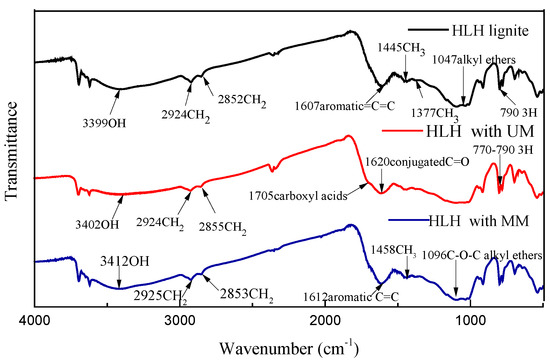
Figure 1.
FTIR spectra of lignite before and after modification.
It can be observed that selected coal samples contain similar functional groups, hence the absorption of sample to infrared spectrum occurs at same wavenumber positions [11]. These obtained spectra are comprehensive curves of many independent peaks, which have to be deconvoluted to achieve. All spectra were divided into 4 regions, namely 700–900 cm−1 (aromatic structures), 1000–1800 cm−1 (oxygen-containing structures), 2800–3000 cm−1 (aliphatic structures) and 3000–3600 cm−1 (hydroxyl structure). Consequently, the area values of specific peak can be derived. The corresponding relationships between peak position and functional group are shown in Table 2, Table 3, Table 4 and Table 5 [12,13].

Table 2.
Aromatic structure of HLH before and after modification.

Table 3.
Oxygen-containing functional group of HLH before and after modification.

Table 4.
Fatty structure of HLH before and after modification.

Table 5.
Hydroxyl structure of HLH before and after modification.
It can be found that there are 3 substitution modes of hydrogen atoms on benzene ring in HLH structure. The proportion of triple substituted aromatics (3H) is the largest among all the samples. The proportion of triple substituted aromatics of HLH raw coal is 86.498%, the MM sample is 86.427% in, the UM sample is 87.893%. The tetrasubstituted hydrocarbons (2H) of HLH lignite has also changed significantly. Tetrasubstituted hydrocarbons (2H) are not found in the infrared spectra of HLH lignite after both modification. In the process of modification, the substitution reaction of aromatic hydrocarbons may cause structural changes, which is due to the instability of other atoms and aliphatic side chains in benzene rings.
It is also found that the form and proportion of oxygen elements in HLH sample changed a lot after modification, however the carbonyl (C=O), alkyl ether (C-O-C), and phenol hydroxyl (-OH) groups are still the main existing forms of oxygen-containing functional group of HLH.
2.2.2. FTIR Structural Parameters Analysis
FTIR structural parameters could be obtained by the area of peak with peak fitting [14,15].
(1) Ratio of hydrogen to carbon H/C.
(2) The aromatic carbon ratio far-F: On the premise of ignoring carbonyl carbon, assuming that coal only contains aromatic carbon and aliphatic carbon, the formula for calculating aromatic carbon rate is as follows:
where aromatic hydrogen ratio Har/H: Cal/C is the ratio of aliphatic carbons to the total number of carbons, H/C represents the ratio of hydrogen to carbon atoms, Hal/Cal is 1.8 for all coal samples, and represents the atomic ratio between hydrogen and carbon in aliphatic groups.
(3) Fat carbon ratio fal-F:
(4) Lipid chain length and branching degree of coal : According to the ratio between CH2 and CH3, namely the area ratio of A(CH2)/A(CH3), the aliphatic group length and the branched chain degree were calculated to determine the aliphatic structural parameters. The intensity ratio of CH2/CH3 was determined by Equation (5):
(5) Alkane branching degree:
Compared with the alkane branching degree of the 3 coal samples from Table 6, the δF of HLH without modification is 47.68% which indicate there were much tertiary carbon and quaternary carbon in HLH raw coal. There were many branching structures in HLH raw coal. After microwave modification, the main structure of HLH is methylene carbon with long straight chain.

Table 6.
FTIR structural parameters of HLH before and after modification.
2.3. 13C NMR Results Analysis
Figure 2 shows 13C NMR spectra of HLH lignite. It is including 2 main peaks. The lipid-carbon peak area with chemical shift of 0–90 × 10−6 and the aromatic-carbon peak area with chemical shift of 90–165 × 10−6. The sample also contains a small amount of carbonyl carbon, with a chemical shift of 165–220 × 10−6 in the peak area [16,17]. The carbon spectra obtained before and after modification were fitted by peak-splitting method, and 9 carbon skeleton structural parameters were obtained. The results are shown in Table 7.
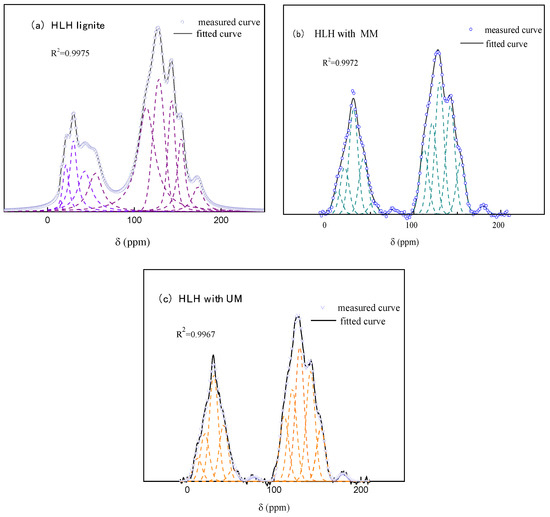
Figure 2.
Peak fit of 13C NMR of HLH before and after modification.

Table 7.
Structure attribution and relative content of chemical shifts in 13C NMR spectra of HLH before and after modification.
XBP = faB/(faH + faO + faS + faB), the ratio of aromatic bridge carbon to peripheral carbon of HLH before and after modification is an important parameter to construct macromolecular structure model of lignite, which represent condensation degree of polycyclic aromatic hydrocarbons as well as reflecting the size of aromatic cluster. According the parameters shown above, the XBP of 3 samples could be calculated, and the value of HLH is 0.26, 0.29 for sample with microwave modification, and 0.28 for sample with ultrasonic modification.
2.4. XPS Results Analysis
2.4.1. Oxygen Element Analysis
XPS is often used to characterize the existence of oxygen, nitrogen and other heteroatoms in coal, which provides an important basis for the construction of macromolecular structure model of HLH [18]. XPS tests of HLH raw coal, microwave modified HLH and ultrasonic modified HLH were carried out, and the XPS maps of 3 samples were processed by peak fitting. The peak-splitting diagram is shown in Figure 3, and the form and content of nitrogen elements are shown in Table 8.
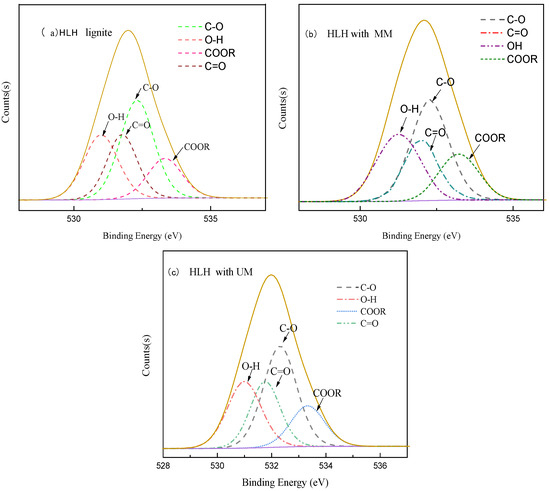
Figure 3.
XPS peak fitting of oxygen atoms of HLH before and after modification.

Table 8.
XPS detection and analysis of oxygen composition forms of HLH before and after modification.
The main forms of oxygen in HLH coal samples are C=O, C-O, -OH and COO-, and it can be found in Table 8 that oxygen exists in most of the four forms of C-O in structure. The content of C-O in HLH samples after microwave modification decreases 2%, but the content of COO-structure form decreases from 14.37% to 35.25% of raw coal. 12.37%. The reason for this change may be that microwave treatment destroys the oxygen structure of HLH raw coal. The content of oxygen-OH and C=O in HLH coal samples treated by ultrasonic wave also increased obviously, while the content of CO-form in opposite direction was still decreasing. Therefore, the microwave and ultrasonic treatment of HLH has different effects on the existing forms of oxygen elements. The stability of COO-and C-O structure forms is relatively poor and easy to be destroyed in the process of modification. On the contrary, the stability of C=O structure makes it not easy to be destroyed in the process of ultrasonic and microwave treatment, which increases the proportion of C=O in the structure.
2.4.2. Nitrogen Element Analysis
Nitrogen in coal mainly comes from coal-forming plants, and most of it exists in the form of organic matter, which mainly includes pyridine nitrogen (N-6), pyrrole nitrogen (N-5), nitrogen oxides (N-X) and proton nitrogen (N-Q) [19,20]. In order to characterize the forms of nitrogen elements in HLH before and after modification, the XPS spectra of HLH lignite were fitted by peak-splitting method. The peak-splitting diagram is shown in Figure 4, and the forms and contents of nitrogen elements are shown in Table 9.
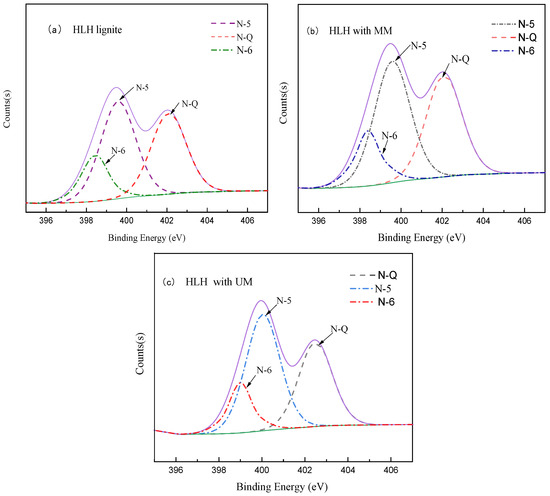
Figure 4.
XPS peak fitting of nitrogen atoms of HLH before and after modification.

Table 9.
XPS detection and analysis of nitrogen composition forms of HLH before and after modification.
By comparing the XPS data of N element in HLH before and after modification, it is obvious that the percentages of N-5, N-6 and N-Q in HLH have changed significantly. The percentage of N-Q in pulverized coal decreased to 31.28% and 30.78% respectively after modification, and the corresponding proportion of N-5 and N-6 increased to varying degrees. The total amount of N-5 and N-6 of modified HLH is nearly 70%. It can be seen that microwave and ultrasonic modification methods mainly play a role in N-Q, while N-5 and N-6 form of nitrogen bond are relatively stable, and the above modification methods have little effect on it. Therefore, in order to make the model representative, N-5 and N-6 nitrogen bonds are often used in the construction of macromolecule HLH lignite structure model.
2.5. Raman Results Analysis
There are two relatively broad D and G peaks in the Raman spectra of HLH, and two vibration peaks have abundant information, the G peak in lignite does not really represent its crystal structure. It mainly reflects the strength of the stretching vibration bond of aromatic rings [21,22]. Raman spectra of coal samples are exhibited in Figure 5.
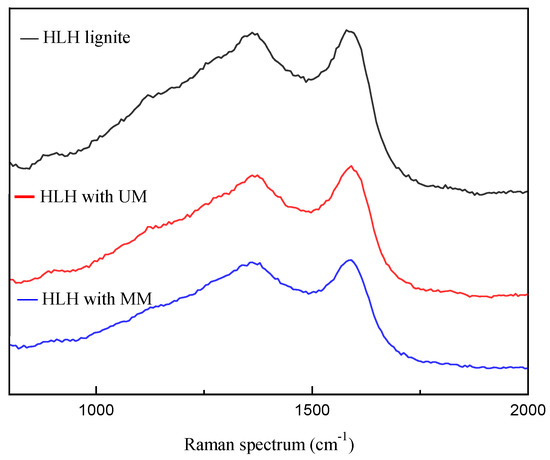
Figure 5.
Raman spectra of HLH coal samples before and after modification.
There are many overlapping peaks between D and G peaks in Raman spectra of coal. In order to obtain more accurate functional group information of HLH lignite before and after modification, Position and area values of D and G peaks of coal samples obtained by deconvolution process of Raman spectra shown in Figure 6. Raman fitting parameters of HLH coal samples before and after modification are shown in Table 10.
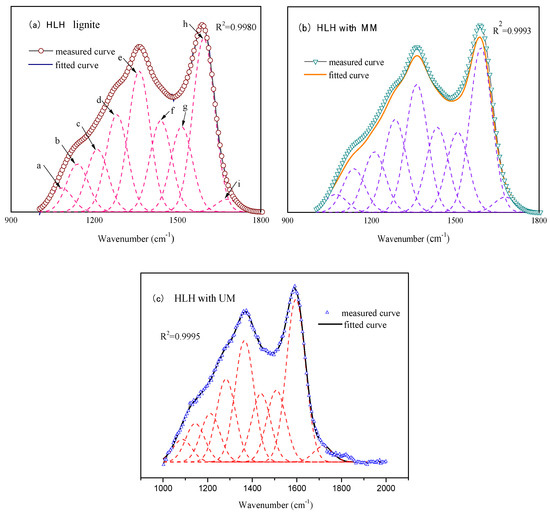
Figure 6.
Raman peak separation fitting charts of HLH coal samples before and after reformation.

Table 10.
Raman spectrum structural parameters of different coal samples.
From the AD and AG values of coal samples before and after modification, it can be found that the D peak area of coal samples after microwave and ultrasonic treatment decreases, especially the D peak area of coal samples after microwave treatment decreases significantly, which also shows that microwave treatment makes HLH structure more complete. Compared with G peak area AG, the AG value of HLH structure after microwave modification is significantly smaller than that of HLH. It can be seen that the total number of aromatic rings in macromolecular structure of HLH treated by microwave is the smallest, and the enrichment degree of aromatic carbon is the lowest, followed by the macromolecular structure of HLH coal treated by ultrasound, while the content of aromatic rings in the macromolecular structure of HLH coal is the highest and the enrichment degree of aromatic carbon is the largest.
ID/IG is usually used to evaluate the disordering degree of carbon materials, and it decreases with the increase of graphitization degree. After microwave treatment, the ID/IG value of HLH was reduced from 0.81 to 0.78. Similarly, after ultrasonic treatment, the ID/IG value of HLH was also reduced to 0.75, and the ID/IG value was reduced. This indicated that the ordering degree of aromatic ring layers in the structure increased and the content of fat chain and side chain decreased after microwave and ultrasonic treatment.
3. HLH Molecular Model Before and After Modification
3.1. Determination of the Type and Number of Aromatic Ring
The average molecular formula of HLH is C167N3O27H149 by elemental analysis. The average molecular formula of microwave modified HLH is C148H129N3O20, and that of ultrasonic modified HLH is C155H131O23N23. Combined with XPS and elemental analysis, it is found that S content in HLH lignite is extremely small. S element was added to the macromolecular model, but it was found that the percentage of S atom in the analysis of experimental elements was about 1.5%, which was obviously inconsistent with the actual results. Therefore, a small amount of S content was neglected in the construction of the macromolecular model of HLH.
XBP is calculated by using the twelve structural parameters, which is calculated by 13C NMR. The ratio of aromatic bridge carbon to periphery carbon of HLH raw coal is 0.26, that of microwave modified HLH is 0.29, and that of ultrasonic modified HLH is 0.28. The XBP of naphthalene ring with two rings is 0.25, and that of anthracene ring with three rings is 0.40. Therefore, the aromatic framework of HLH raw coal structure model is mainly composed of benzene ring and naphthalene ring. After HLH with microwave modification model and HLH with ultrasonic modification aromatic framework is mainly composed of naphthalene ring, with anthracene ring and benzene ring supplemented. In order to make the XBP of HLH raw coal and HLH model after microwave and ultrasonic modification close to 0.26, 0.29 and 0.28, the combination number of benzene, naphthalene and anthracene rings in its structural model needs to be adjusted continuously. The type and number of aromatic rings in the three structural models are determined. The results are shown in Table 11.

Table 11.
Type and quantities of aromatic rings of HLH before and after modification.
Comparing the previous 13C NMR and FTIR spectra, it is found that the proportion of oxygen bonded by carbon-oxygen double bond is much smaller than that bonded by carbon-oxygen single bond, which is consistent with the XPS test results. This shows that the main forms of oxygen in macromolecular structure before and after HLH modification are mostly in the form of ether bond and hydroxyl bond of carbon-oxygen single bond, and the other oxygen-containing structures are in the second place. The final form of oxygen in the structure is determined by constantly adjusting the structure of oxygen.
The main forms of nitrogen in HLH macromolecular structure are pyridine nitrogen and pyrrole nitrogen. According to XPS analysis, the number of nitrogen atoms is always 3 of HLH before and after modification, and the main forms of nitrogen elements were pyridine nitrogen and pyrrole nitrogen the content ratio was 2:1. Therefore, two pyridine rings and one pyrrole ring were added to the HLH structure model before and after modification.
3.2. Model Construction
Wiser coal chemical model is used as the basis, which is widely accepted and considered to be comprehensive and reasonable. Combining with the above calculation results, the existing forms and proportions of each part of the macromolecular structure model before and after modification of HLH are summarized and analyzed. Finally, the two-dimensional molecular model of HLH before and after modification is preliminarily established according to the chemical structure characteristics obtained from the experiments. As shown in Figure 7, Figure 8 and Figure 9.
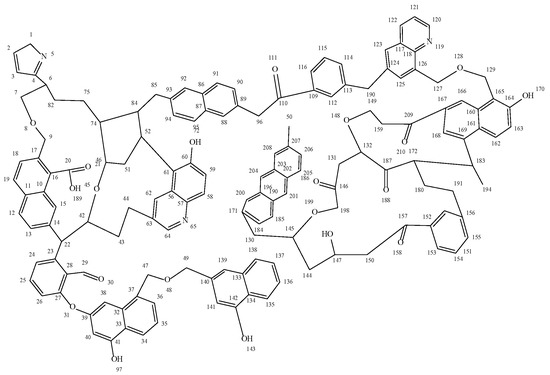
Figure 7.
Final two-dimensional model macromolecular structure diagram of HLH.
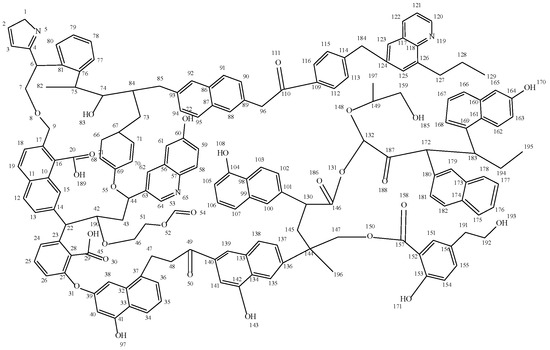
Figure 8.
Final two-dimensional model macromolecular structure of HLH after microwave modification.

Figure 9.
Final two-dimensional model macromolecular structure of HLH after Ultrasonic modification.
3.3. Verification of Model
The 13C NMR chemical shifts of the three models were calculated and compared with the experimental 13C NMR chemical shifts. Because of the complexity and diversity of coal’s macromolecule structure, it is necessary to constantly adjust the types and quantities of its structural units in the construction process, so as to make its 13C NMR simulation spectra better consistent with the experimental spectra. The comparison of 13C NMR simulation spectra and experimental spectra of the three models is shown in Figure 10.
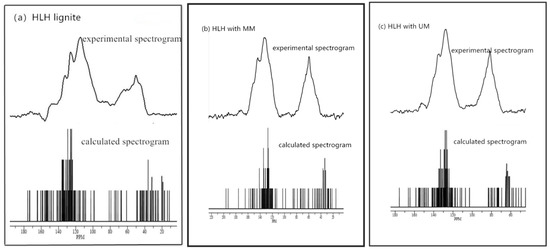
Figure 10.
Comparison of 13C NMR computational spectra and experimental spectra of HLH final two-dimensional model before and after modification: (a) HLH, (b) HLH after microwave modification, (c) HLH after Ultrasonic modification.
It can be seen that the 13C NMR simulation spectra of the three models are in good agreement with the experimental spectra. There are some errors between the two spectra due to some uncontrollable factors in the experimental process, but it is considered acceptable and will not affect the characterization of average macromolecular structure of HLH coal samples.
In order to adjust the structure of the model to approximate the experimental data, most researchers adopted the simulation of 13C NMR spectrum, but which cannot avoid the choice of isomers [23,24]. At the same time, the model obtained by this method is only a conceptual structure, which cannot reflect the properties of chemical reactions. By using the main covalent bond concentration instead of the 13C NMR simulation spectrum, the molecular model can be better corrected. According to the 11 structural parameters (fa, faH, faO, faB, faS, faC, fal, falA, falM, falH, falO) obtained from 13C NMB data, nine covalent bond concentrations of HLH lignite (Car-Car, Car-Cal, Cal-Cal, Car-H, Cal-H, Car-O, Cal-O, Cal=O, and O-H.) can be obtained. This covalent concentration method reflects the essence of 13C NMR simulation spectroscopy. By comparing the simulated concentration of the main covalent bond with the experimental results, the preliminary two-dimensional molecular model is modified. The concentrations of nine types covalent bonds in coal can be determined by Equations (7)–(15).
Based on the formula, the information of covalent bond concentration of the three final planar model structures is calculated and summarized in Table 12, in order to more intuitively compare and analyze the difference between the covalent bond concentration obtained from the experiment and that calculated from the model. Then, the molecular models of the three structures obtained from HLH raw coal, microwave, and ultrasonic upgrading of HLH coal, respectively, were adjusted.

Table 12.
Covalent bond concentrations of 3 structural models of HLH before and after modification.
According to the covalent bond concentration obtained from the experiment and the concentration calculated by the model, it was found that the concentration of the nine covalent bonds is not different from that calculated by the model, but the difference between the experimental concentration of conCal-Cal and conCar-H and the calculated concentration of the model is relatively large. The reason for this may be that there is a certain difference between the proportion of elements in the model and that in the experimental measurement, which makes the calculation of the nine covalent bonds concentration more intensive.
3.4. Adjustment of Model
After the final model of molecular structure is obtained, the molecular formulas and element contents of the three models of HLH under different modification conditions are calculated. By comparing the results of Table 13 and Table 14, it can be seen that the element contents of the three models are very close to the experimental values, and there is no significant difference, which verifies the reliability of the model.

Table 13.
Element content measured by experiments of HLH before and after modification.

Table 14.
Molecular formula and element content of the model of HLH before and after modification.
3.5. Construction of 3- Dimensional Model
The three-dimensional model is constructed for the 2- dimensional structure of HLH before and after modification, whose three-dimensional geometric optimization configuration is calculated by MM and MD of Forcite module in Materials Studio 8.0 software. The structure model of HLH before and after optimization is shown in Figure 11, Figure 12 and Figure 13, and the energy change in the process of optimization is shown in Table 15.

Figure 11.
3-dimensional structure of HLH lignite model before and after geometric optimization.

Figure 12.
3-dimensional structure of HLH lignite model modified by microwave before and after geometric optimization.

Figure 13.
3-dimensional structure of HLH lignite model modified by ultrasound before and after geometric optimization.

Table 15.
Energy comparison before and after HLH structural model optimization.
It can be seen from this that the total energy of the minimum energy structures of the three structures decreases sharply. Compared with other terms, the value of Van der Waals energy (EVan) in the non-bonding energy is the largest, which constitutes the most important part of the potential energy. Therefore, the decrease of the inter-molecular Van der Waals energy (EVan) is also the main factor that makes the HLH macromolecular structure model stable in space.
4. Conclusions
(1) The molecular formula of the three structures was determined by elemental analysis. The average molecular formula of HLH raw coal configuration was C167N3O27H149, and the aromatic part consists of five benzene rings, six naphthalene rings, two pyrrole rings and one pyridine ring. The average molecular formula of Mm coal configuration was C148H129N3O20, the aromatic structure includes three benzene rings, four anthracene rings, four naphthalene rings, one anthracene ring, one pyridine ring and two pyrrole rings. And the average molecular formula of Um coal configuration was C155H131O23N23, the aromatic structure includes three benzene rings, five anthracene rings, four naphthalene rings, one anthracene ring, one pyridine ring, and two pyrrole rings.
(2) It was found that after microwave and ultrasonic treatment, the orderliness of aromatic ring layer arrangement increased. The content of fat chain and side chain decreased, and the existence form of oxygen atoms also changed, in which the proportion of C-O and COO- form shows a decreasing trend. It was found that the total energy of the three structures decreased significantly after optimization. The chemical bonds between the atoms are obviously bent and distorted, and the space configuration is more stereoscopic. Although the model constructed in this paper is not the most comprehensive and optimized configuration before and after HLH modification, some problems such as isomers are considered in the process of construction, which has a certain reference value for better understanding and application of lignite upgrading.
Author Contributions
J.L. provided methodology and original draft writing. Z.H. and Y.Y. conceived and designed the study. S.Q. performed the experiments. Y.Y. provided the samples. S.Q. wrote the paper. Z.H. reviewed and edited the manuscript. All authors have read and agreed to the published version of the manuscript.
Funding
This work was financially supported by National Natural Science Foundation of China (51874171) and and University of Science and Technology Liaoning Talent Project Grants (No. 601011507-05).
Conflicts of Interest
The authors declared that they have no conflict of interest to this work. We declare that we do not have any commercial or associative interest that represents a conflict of interest in connection with the work submitted.
References
- He, Q.Q.; Wan, K.; Hoadley, A.; Yeasmin, H.; Miao, Z.Y. TG–GC–MS study of volatile products from Shengli lignite pyrolysis. Fuel 2015, 156, 121–128. [Google Scholar] [CrossRef]
- Liu, P.; Zhang, D.X.; Wang, L.L.; Zhou, Y.; Pan, T.Y.; Lu, X.L. The structure and pyrolysis product distribution of lignite from different sedimentary environment. Appl. Energy 2016, 163, 254–262. [Google Scholar] [CrossRef]
- Zhao, H.; Guo, F.; Yang, J. Adsorption characteristic of Indonesia lignite and dewater experiment. J. China Coal Soc. 2008, 33, 799–802. [Google Scholar]
- Hua, Z.; Qin, Z. Solubilization rules of small molecules with different states under ultrasonic extraction. J. China Univ. Min. Technol. 2012, 41, 91–94. [Google Scholar]
- Tahmasebi, A.; Yu, J.; Li, X.; Meesri, C. Experimental study on microwave drying of Chinese and Indonesian low-rank coals. Fuel Process. Technol. 2011, 92, 1821–1829. [Google Scholar] [CrossRef]
- Sun, Q.; Zhang, Y.; Li, Q. Physical and chemical characteristics and gasification reactivity of lignite fast pyrolysis char. J. Zhejiang Univ. (Eng. Sci.) 2016, 50, 2045–2051. [Google Scholar]
- Ge, L. Basic Research on Typical Low-Quality Coal Upgrading and Poly-Generation System Based on the Cascade Utilization of Coal. Ph.D. Thesis, Zhejiang University, Hangzhou, China, 2014; pp. 1–10. [Google Scholar]
- Castro-Marcano, F.; Russuo, M.F., Jr.; van Duin, A.C.T.; Mathews, J.P. Pyrolysis of a large-scale molecular model for Illinois no. 6 coal using the ReaxFF reactive force field. J. Anal. Appl. Pyrolysis 2014, 109, 79–89. [Google Scholar] [CrossRef]
- Cui, W.; Li, M.; Gong, G.; Lu, K.; Sun, S.; Dong, F. Guided trilateral filter and its application to ultrasound image despeckling. Biomed. Signal Process. Control 2020, 55, 101625. [Google Scholar] [CrossRef]
- Mokhtar, N.M.; Omar, R.; Idris, A. Microwave pyrolysis for conversion of materials to energy: A brief review. Energy Sources Part A Recovery Util. Environ. Eff. 2012, 34, 2104–2122. [Google Scholar] [CrossRef]
- Han, F.; Meng, A.H.; Li, Q.H.; Zhang, Y. Thermal decomposition and evolved gas analysis (TG-MS) of lignite coals from Southwest China. J. Energy Inst. 2016, 89, 94–100. [Google Scholar] [CrossRef]
- Li, X.; Zeng, F.G.; Wang, W.; Dong, K.; Cheng, L.Y. FTIR characterization of structural evolution in low-middle rank coals. J. China Coal Soc. 2015, 40, 2900–2908. [Google Scholar]
- Yang, F.; Hou, Y.; Wu, W.; Niu, M.; Ren, S.; Wang, Q. A new insight into the structure of Huolinhe lignite based on the yields of benzene carboxylic acids. Fuel 2017, 189, 408–418. [Google Scholar] [CrossRef]
- Xu, F.; Pan, S.; Liu, C.; Zhao, D.; Liu, H.; Wang, Q.; Liu, Y. Construction and evaluation of chemical structure model of Huolinhe lignite using molecular modeling. RSC Adv. 2017, 7, 41512–41519. [Google Scholar] [CrossRef]
- Liang, H.Z.; Wang, C.G.; Zeng, F.G.; Li, M.F.; Xiang, J.H. Effect of demineralization on lignite structure from Yinmin coalfield by FT-IR investigation. J. Fuel Chem. Technol. 2014, 42, 129–137. [Google Scholar]
- Guo, D.Y.; Ye, J.W.; Wang, Q.B.; Guo, X.J. FT-IR and 13C-NMR characterizations for deformed coal in Pingdingshan mining. J. China Coal Soc. 2016, 41, 3040–3046. [Google Scholar]
- Wang, Y.G.; Zhou, J.L.; Chen, Y.J.; Hu, X.; Zhang, S.; Lin, X. Contents of O-containing functional groups in coals by 13C-NMR analysis. J. Fuel Chem. Technol. 2013, 41, 1422–1426. [Google Scholar]
- Wang, J.; He, Y.; Li, H.; Yu, J.; Xie, W.; Wei, H. The molecular structure of Inner Mongolia lignite utilizing XRD, solid state 13 C NMR, HRTEM and XPS techniques. Fuel 2017, 203, 764–773. [Google Scholar] [CrossRef]
- Wang, Q.; Liu, Q.; Wang, Z.C.; Liu, H.P.; Bai, J.R.; Ye, J.B. Characterization of organic nitrogen and sulfur in the oil shale kerogens. Fuel Process. Technol. 2017, 160, 170–177. [Google Scholar] [CrossRef]
- Kelemen, S.R.; Afeworki, M.; Gorbaty, M.L.; Sansone, M.; Kwiatek, P.J.; Walters, C.C.; Freund, H.; Siskin, M. Direct characterization of Kerogen by X-ray and solid-state 13C nuclear magnetic resonance methods. Energy Fuels 2007, 21, 1548–1561. [Google Scholar] [CrossRef]
- Zerda, T.W.; John, A.; Chmura, K. Raman studies of coals. Fuel 1981, 60, 375–378. [Google Scholar] [CrossRef]
- Li, M.F.; Zeng, F.G.; Qi, F.H.; Sun, B.L. Raman spectral characteristics of different coal grades and their relationship with XRD structural parameters. Spectrosc. Spectr. Anal. 2009, 29, 2446–2449. [Google Scholar]
- Takanohashi, T.; Kawashima, H. Construction of a model structure for upper Freeport coal using 13C NMR chemical shift calculations. Energy Fuels 2002, 16, 379–387. [Google Scholar] [CrossRef]
- Xiang, J.H.; Zeng, F.G.; Liang, H.Z.; Sun, B.L.; Zhang, L.; Li, M.F.; Jia, J.B. Model construction of the macromolecular structure of Yanzhou coal and its molecular simulation. J. Fuel Chem. Technol. 2011, 39, 481–488. [Google Scholar] [CrossRef]
© 2020 by the authors. Licensee MDPI, Basel, Switzerland. This article is an open access article distributed under the terms and conditions of the Creative Commons Attribution (CC BY) license (http://creativecommons.org/licenses/by/4.0/).




